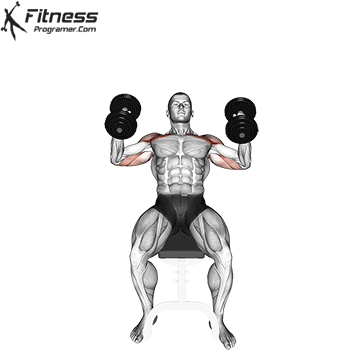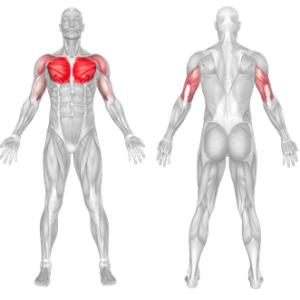Incline Dumbbell Hammer Press Overview
The incline dumbbell hammer press is a strength training exercise that primarily targets the upper chest muscles. Performed on an incline bench with a neutral grip (palms facing each other), this variation shifts emphasis to the upper portion of the chest (clavicular head) while also engaging the triceps and anterior deltoids. The hammer grip reduces stress on the shoulders and wrists, making it a joint-friendly alternative to incline presses.
How to do:

Set an incline bench at a 30 or 45-degree angle and select a pair of dumbbells that are appropriate for your strength level.
- Sit on the bench with your feet flat on the floor and your back against the bench.
- Hold the dumbbells in a hammer grip (palms facing each other) with your elbows bent at a 90-degree angle and your upper arms parallel to the floor.
- Inhale and press the dumbbells up above your chest, extending your arms fully.
- Pause briefly at the top of the movement and then slowly lower the dumbbells back to the starting position, keeping your elbows at a 90-degree angle.
- Exhale as you press the dumbbells back up and repeat for the desired number of repetitions.
Coach Tips
- Focus on Form: Maintain proper alignment and control throughout the movement.
- Squeeze at the Top: Consciously engage your chest muscles at the peak of the press.
- Warm Up: Prepare your shoulders and chest with light exercises to prevent injury.
- Use Moderate Weight: Start with a weight that allows you to perform the exercise with perfect form.
- Combine with Other Chest Exercises: Pair with flat and decline presses for comprehensive chest development.
Common Mistakes to Avoid
- Using Excessive Weight: Too much weight can compromise form and lead to injury.
- Incorrect Bench Angle: A steep incline shifts focus to the shoulders; stick to 30–45 degrees for optimal chest activation.
- Rushing the Movement: Perform the exercise slowly and controlled to maximize muscle engagement.
- Overarching the Lower Back: Keep your core engaged and your back flat against the bench.
- Partial Range of Motion: Fully extend and lower the dumbbells for maximum chest engagement.
Benefits Of Incline Dumbbell Hammer Press
1. Upper Chest Focus
The incline angle positions the torso to emphasize the clavicular head of the pectoralis major, or the upper chest. Regularly including this exercise in your routine contributes to a fuller and more developed chest, especially for those who feel their upper chest is underdeveloped. Enhances the overall symmetry and proportion of the chest when paired with flat and decline exercises.
2. Improved balance and stability:
The use of dumbbells requires more stabilization from the muscles and joints, which can help to improve overall balance and stability.
3. Joint-Friendly Grip
The neutral (hammer) grip keeps the shoulders in a more natural position, reducing the risk of strain or discomfort. Encourages proper alignment of the elbows and wrists, providing a safer pressing motion. Ideal for individuals with shoulder or wrist issues who may find traditional pronated grips uncomfortable.
4. Greater range of motion:
The incline angle of the bench allows for a greater range of motion compared to a flat bench, which can lead to greater muscle activation and development.
5. Variability in training:
Adding incline dumbbell hammer press to your workout routine provides a variation from traditional bench press, targeting different muscles group to overall strength gains.
Incline Dumbbell Hammer Press: Muscles Worked

